Expert Evidence Admissibility and Property Documents
VerifiedAdded on 2021/04/17
|14
|2745
|144
AI Summary
This assignment involves analyzing the legal principles surrounding expert witness testimony, specifically in the context of a case involving possession of controlled substances. The application of these principles to determine whether Mrs. Nisha Hunter's expert evidence is admissible is examined. Additionally, the obligation of Rob's solicitor to hand over documents related to property purchases or plans is discussed in light of the Misuse of Drugs Act 1971 and its implications for the trial.
Contribute Materials
Your contribution can guide someone’s learning journey. Share your
documents today.
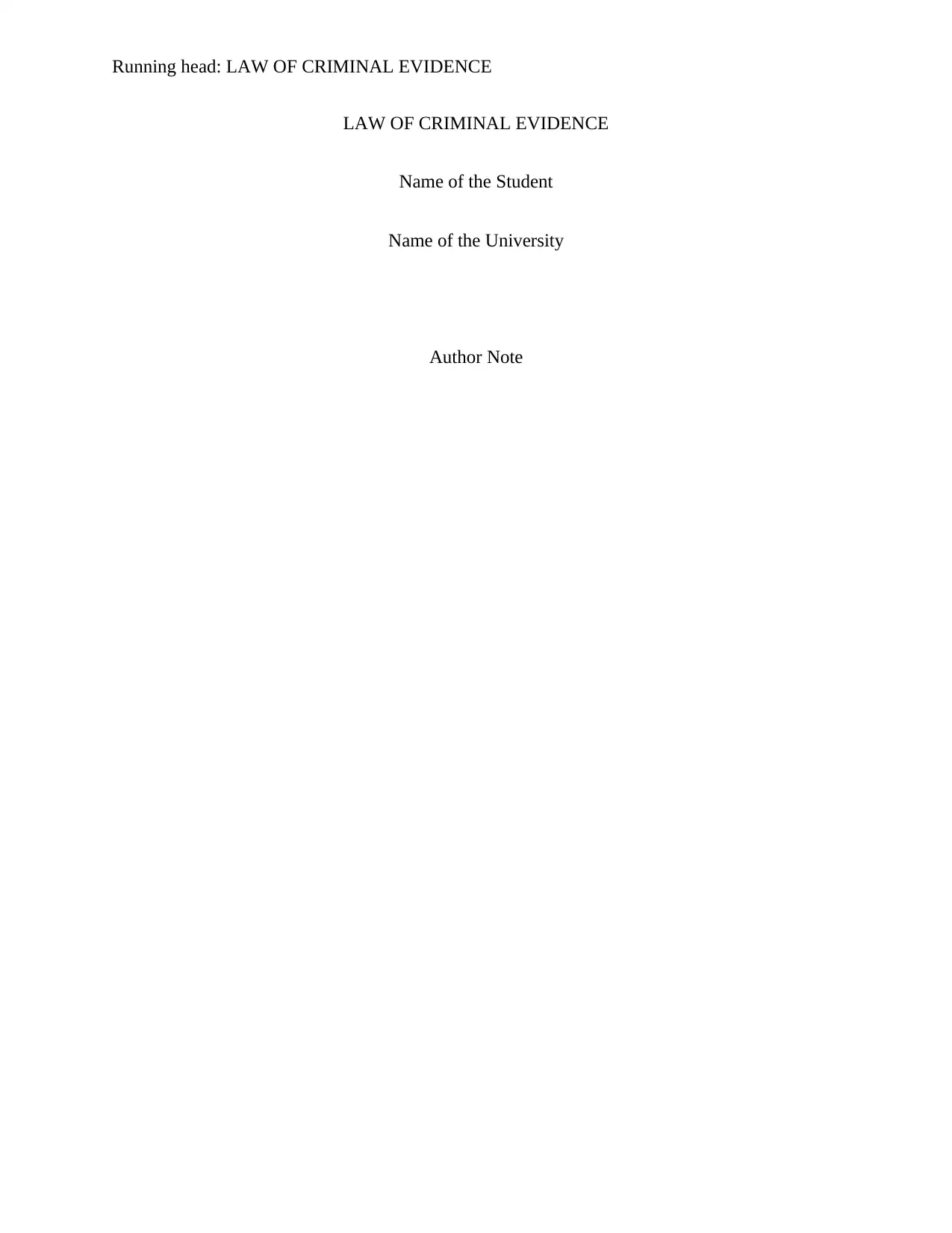
Running head: LAW OF CRIMINAL EVIDENCE
LAW OF CRIMINAL EVIDENCE
Name of the Student
Name of the University
Author Note
LAW OF CRIMINAL EVIDENCE
Name of the Student
Name of the University
Author Note
Secure Best Marks with AI Grader
Need help grading? Try our AI Grader for instant feedback on your assignments.
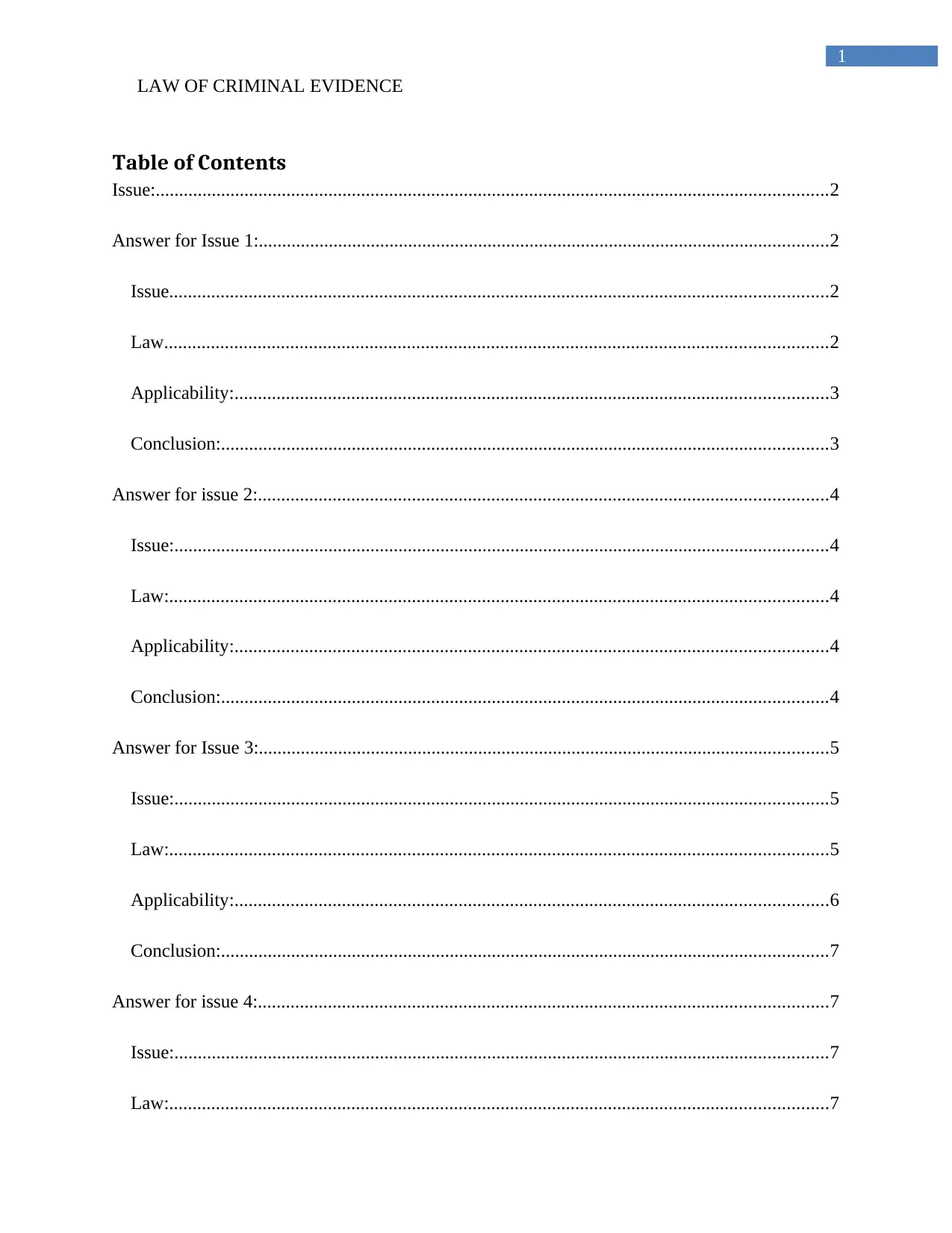
1
LAW OF CRIMINAL EVIDENCE
Table of Contents
Issue:................................................................................................................................................2
Answer for Issue 1:..........................................................................................................................2
Issue.............................................................................................................................................2
Law..............................................................................................................................................2
Applicability:...............................................................................................................................3
Conclusion:..................................................................................................................................3
Answer for issue 2:..........................................................................................................................4
Issue:............................................................................................................................................4
Law:.............................................................................................................................................4
Applicability:...............................................................................................................................4
Conclusion:..................................................................................................................................4
Answer for Issue 3:..........................................................................................................................5
Issue:............................................................................................................................................5
Law:.............................................................................................................................................5
Applicability:...............................................................................................................................6
Conclusion:..................................................................................................................................7
Answer for issue 4:..........................................................................................................................7
Issue:............................................................................................................................................7
Law:.............................................................................................................................................7
LAW OF CRIMINAL EVIDENCE
Table of Contents
Issue:................................................................................................................................................2
Answer for Issue 1:..........................................................................................................................2
Issue.............................................................................................................................................2
Law..............................................................................................................................................2
Applicability:...............................................................................................................................3
Conclusion:..................................................................................................................................3
Answer for issue 2:..........................................................................................................................4
Issue:............................................................................................................................................4
Law:.............................................................................................................................................4
Applicability:...............................................................................................................................4
Conclusion:..................................................................................................................................4
Answer for Issue 3:..........................................................................................................................5
Issue:............................................................................................................................................5
Law:.............................................................................................................................................5
Applicability:...............................................................................................................................6
Conclusion:..................................................................................................................................7
Answer for issue 4:..........................................................................................................................7
Issue:............................................................................................................................................7
Law:.............................................................................................................................................7
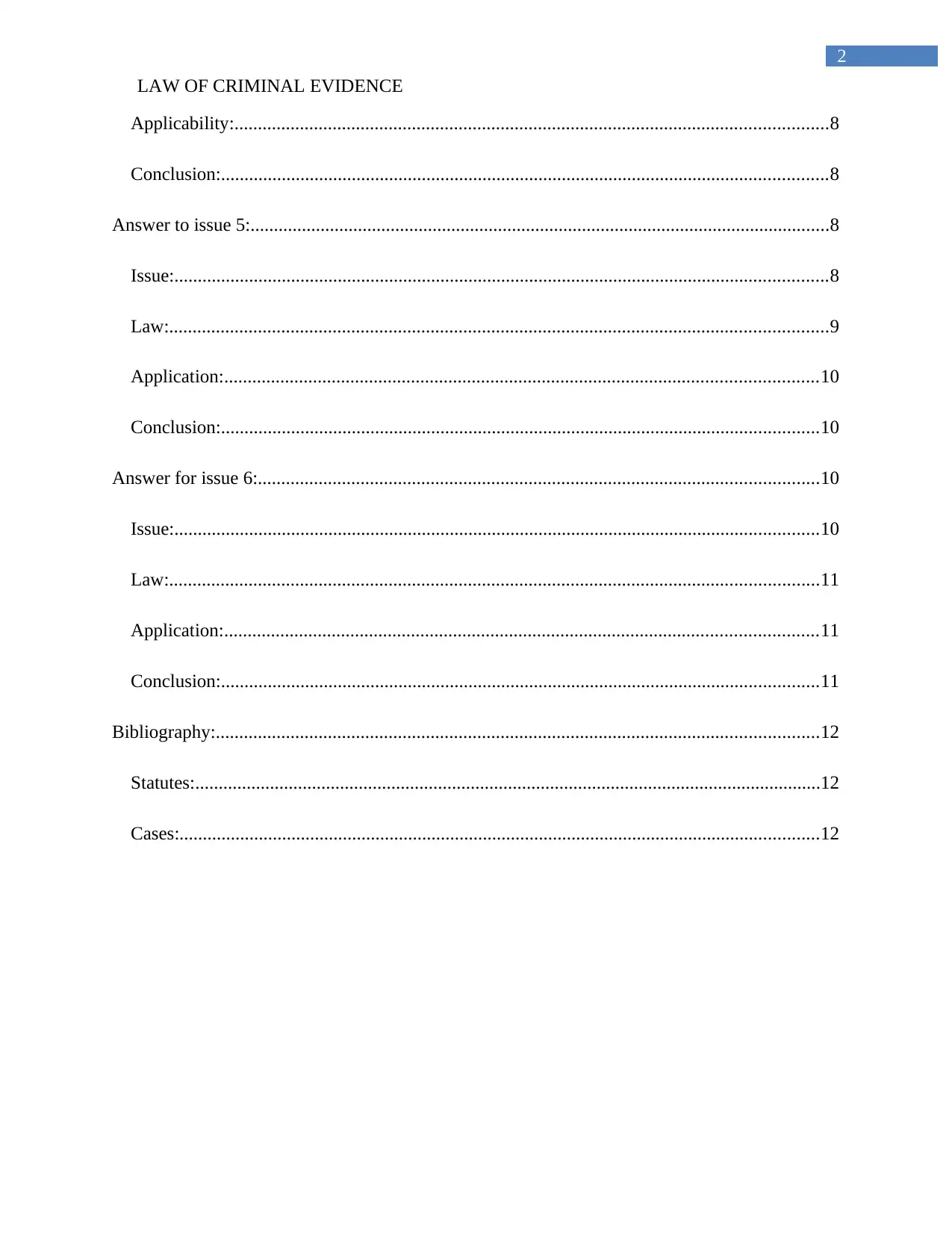
2
LAW OF CRIMINAL EVIDENCE
Applicability:...............................................................................................................................8
Conclusion:..................................................................................................................................8
Answer to issue 5:............................................................................................................................8
Issue:............................................................................................................................................8
Law:.............................................................................................................................................9
Application:...............................................................................................................................10
Conclusion:................................................................................................................................10
Answer for issue 6:........................................................................................................................10
Issue:..........................................................................................................................................10
Law:...........................................................................................................................................11
Application:...............................................................................................................................11
Conclusion:................................................................................................................................11
Bibliography:.................................................................................................................................12
Statutes:......................................................................................................................................12
Cases:.........................................................................................................................................12
LAW OF CRIMINAL EVIDENCE
Applicability:...............................................................................................................................8
Conclusion:..................................................................................................................................8
Answer to issue 5:............................................................................................................................8
Issue:............................................................................................................................................8
Law:.............................................................................................................................................9
Application:...............................................................................................................................10
Conclusion:................................................................................................................................10
Answer for issue 6:........................................................................................................................10
Issue:..........................................................................................................................................10
Law:...........................................................................................................................................11
Application:...............................................................................................................................11
Conclusion:................................................................................................................................11
Bibliography:.................................................................................................................................12
Statutes:......................................................................................................................................12
Cases:.........................................................................................................................................12
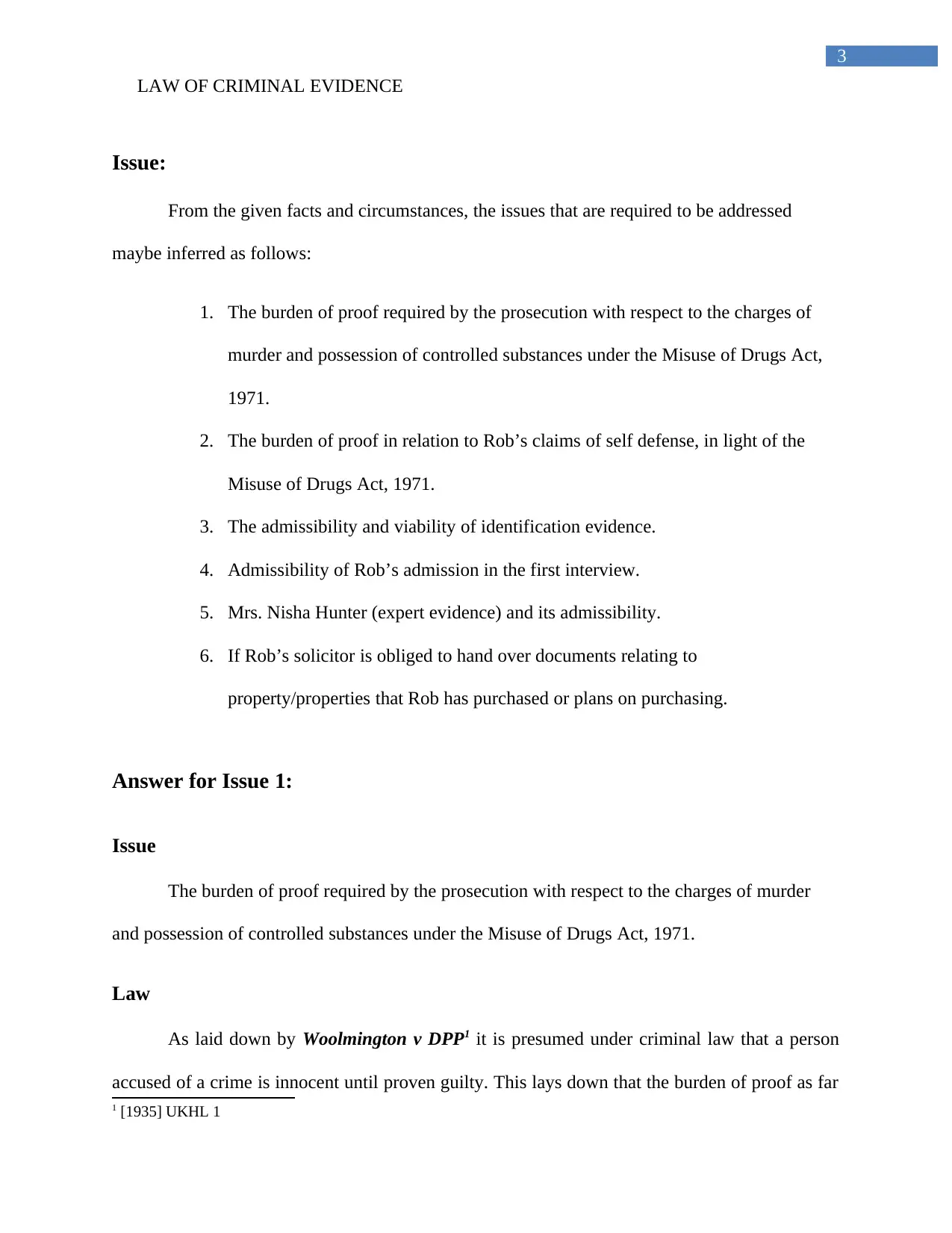
3
LAW OF CRIMINAL EVIDENCE
Issue:
From the given facts and circumstances, the issues that are required to be addressed
maybe inferred as follows:
1. The burden of proof required by the prosecution with respect to the charges of
murder and possession of controlled substances under the Misuse of Drugs Act,
1971.
2. The burden of proof in relation to Rob’s claims of self defense, in light of the
Misuse of Drugs Act, 1971.
3. The admissibility and viability of identification evidence.
4. Admissibility of Rob’s admission in the first interview.
5. Mrs. Nisha Hunter (expert evidence) and its admissibility.
6. If Rob’s solicitor is obliged to hand over documents relating to
property/properties that Rob has purchased or plans on purchasing.
Answer for Issue 1:
Issue
The burden of proof required by the prosecution with respect to the charges of murder
and possession of controlled substances under the Misuse of Drugs Act, 1971.
Law
As laid down by Woolmington v DPP1 it is presumed under criminal law that a person
accused of a crime is innocent until proven guilty. This lays down that the burden of proof as far
1 [1935] UKHL 1
LAW OF CRIMINAL EVIDENCE
Issue:
From the given facts and circumstances, the issues that are required to be addressed
maybe inferred as follows:
1. The burden of proof required by the prosecution with respect to the charges of
murder and possession of controlled substances under the Misuse of Drugs Act,
1971.
2. The burden of proof in relation to Rob’s claims of self defense, in light of the
Misuse of Drugs Act, 1971.
3. The admissibility and viability of identification evidence.
4. Admissibility of Rob’s admission in the first interview.
5. Mrs. Nisha Hunter (expert evidence) and its admissibility.
6. If Rob’s solicitor is obliged to hand over documents relating to
property/properties that Rob has purchased or plans on purchasing.
Answer for Issue 1:
Issue
The burden of proof required by the prosecution with respect to the charges of murder
and possession of controlled substances under the Misuse of Drugs Act, 1971.
Law
As laid down by Woolmington v DPP1 it is presumed under criminal law that a person
accused of a crime is innocent until proven guilty. This lays down that the burden of proof as far
1 [1935] UKHL 1
Secure Best Marks with AI Grader
Need help grading? Try our AI Grader for instant feedback on your assignments.
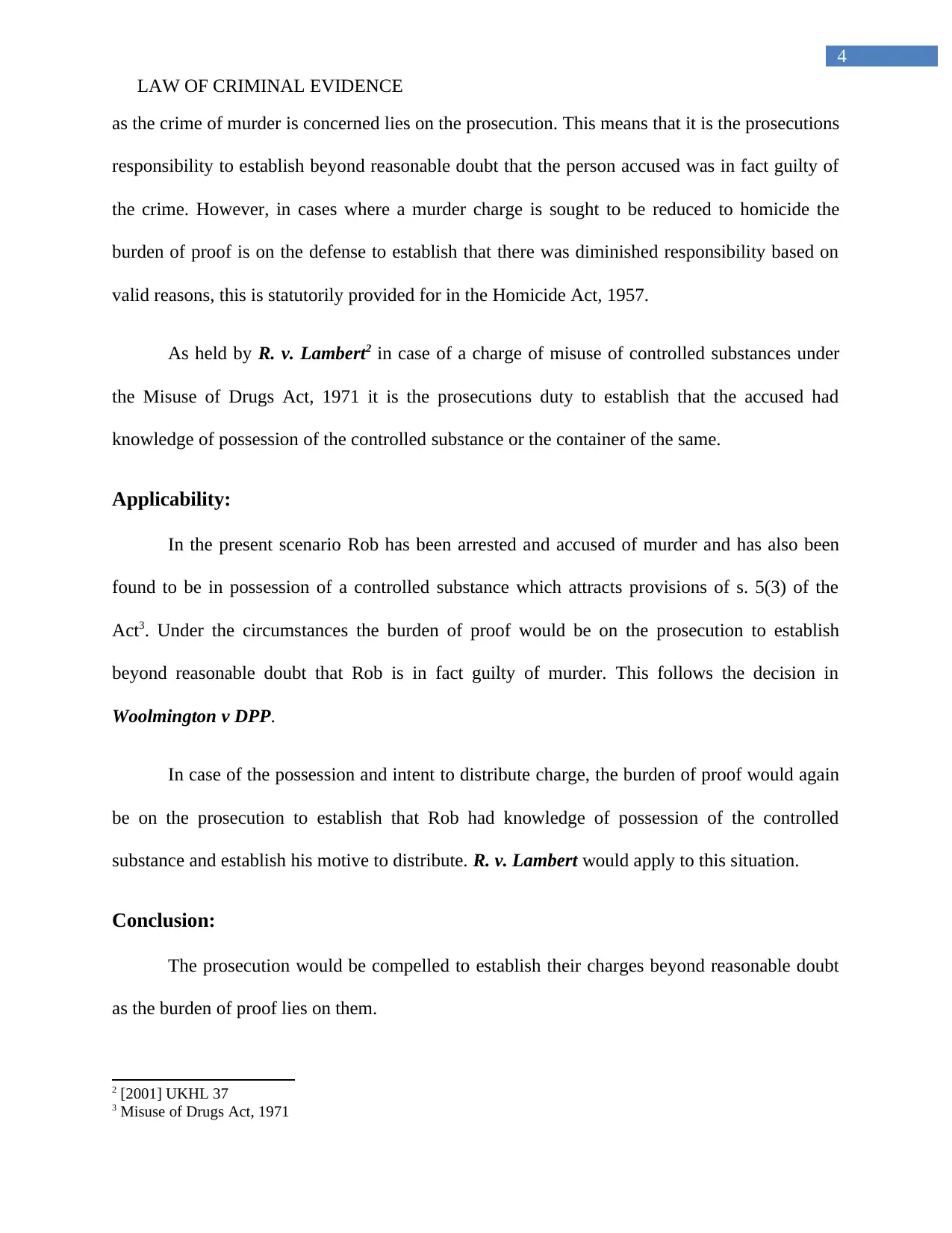
4
LAW OF CRIMINAL EVIDENCE
as the crime of murder is concerned lies on the prosecution. This means that it is the prosecutions
responsibility to establish beyond reasonable doubt that the person accused was in fact guilty of
the crime. However, in cases where a murder charge is sought to be reduced to homicide the
burden of proof is on the defense to establish that there was diminished responsibility based on
valid reasons, this is statutorily provided for in the Homicide Act, 1957.
As held by R. v. Lambert2 in case of a charge of misuse of controlled substances under
the Misuse of Drugs Act, 1971 it is the prosecutions duty to establish that the accused had
knowledge of possession of the controlled substance or the container of the same.
Applicability:
In the present scenario Rob has been arrested and accused of murder and has also been
found to be in possession of a controlled substance which attracts provisions of s. 5(3) of the
Act3. Under the circumstances the burden of proof would be on the prosecution to establish
beyond reasonable doubt that Rob is in fact guilty of murder. This follows the decision in
Woolmington v DPP.
In case of the possession and intent to distribute charge, the burden of proof would again
be on the prosecution to establish that Rob had knowledge of possession of the controlled
substance and establish his motive to distribute. R. v. Lambert would apply to this situation.
Conclusion:
The prosecution would be compelled to establish their charges beyond reasonable doubt
as the burden of proof lies on them.
2 [2001] UKHL 37
3 Misuse of Drugs Act, 1971
LAW OF CRIMINAL EVIDENCE
as the crime of murder is concerned lies on the prosecution. This means that it is the prosecutions
responsibility to establish beyond reasonable doubt that the person accused was in fact guilty of
the crime. However, in cases where a murder charge is sought to be reduced to homicide the
burden of proof is on the defense to establish that there was diminished responsibility based on
valid reasons, this is statutorily provided for in the Homicide Act, 1957.
As held by R. v. Lambert2 in case of a charge of misuse of controlled substances under
the Misuse of Drugs Act, 1971 it is the prosecutions duty to establish that the accused had
knowledge of possession of the controlled substance or the container of the same.
Applicability:
In the present scenario Rob has been arrested and accused of murder and has also been
found to be in possession of a controlled substance which attracts provisions of s. 5(3) of the
Act3. Under the circumstances the burden of proof would be on the prosecution to establish
beyond reasonable doubt that Rob is in fact guilty of murder. This follows the decision in
Woolmington v DPP.
In case of the possession and intent to distribute charge, the burden of proof would again
be on the prosecution to establish that Rob had knowledge of possession of the controlled
substance and establish his motive to distribute. R. v. Lambert would apply to this situation.
Conclusion:
The prosecution would be compelled to establish their charges beyond reasonable doubt
as the burden of proof lies on them.
2 [2001] UKHL 37
3 Misuse of Drugs Act, 1971
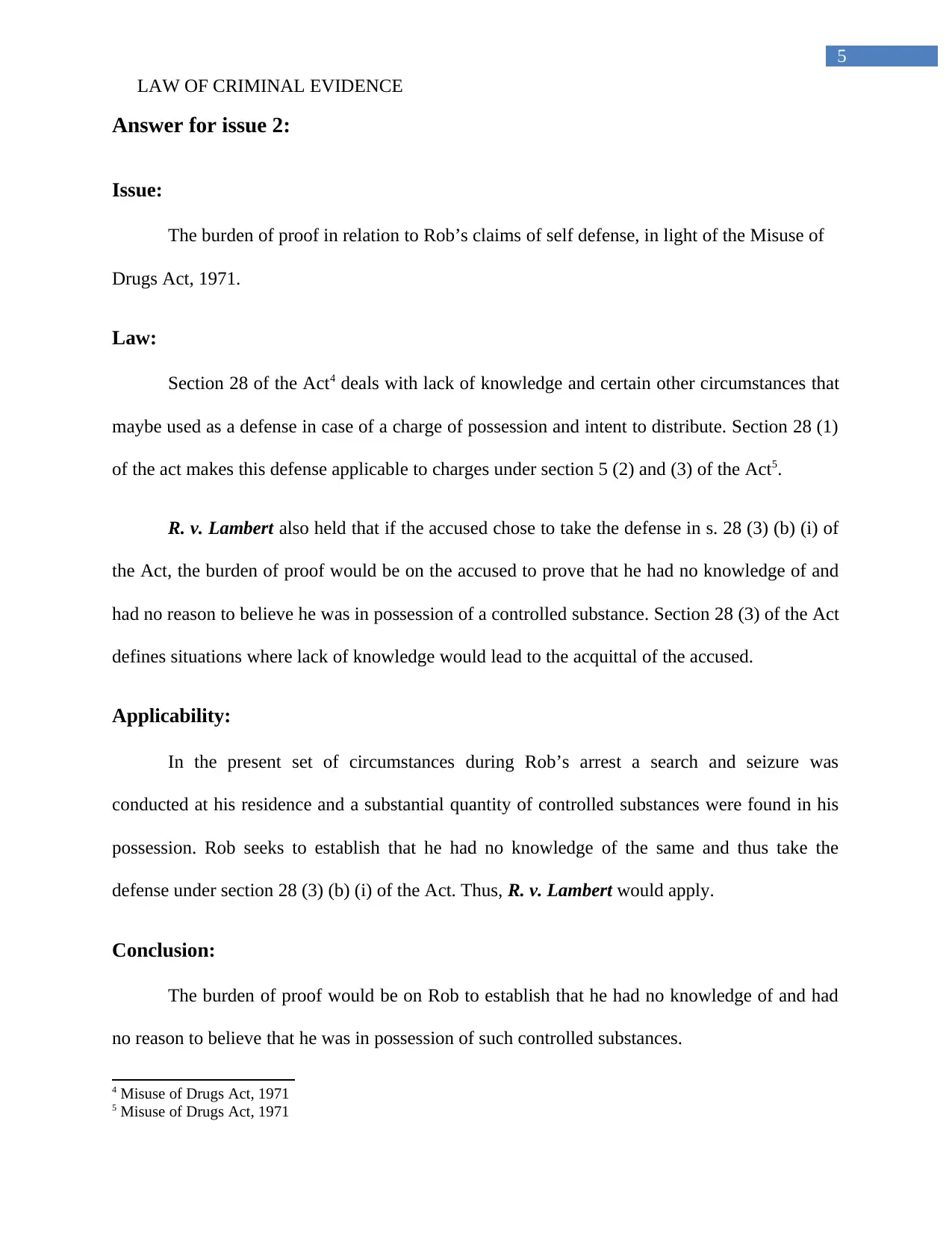
5
LAW OF CRIMINAL EVIDENCE
Answer for issue 2:
Issue:
The burden of proof in relation to Rob’s claims of self defense, in light of the Misuse of
Drugs Act, 1971.
Law:
Section 28 of the Act4 deals with lack of knowledge and certain other circumstances that
maybe used as a defense in case of a charge of possession and intent to distribute. Section 28 (1)
of the act makes this defense applicable to charges under section 5 (2) and (3) of the Act5.
R. v. Lambert also held that if the accused chose to take the defense in s. 28 (3) (b) (i) of
the Act, the burden of proof would be on the accused to prove that he had no knowledge of and
had no reason to believe he was in possession of a controlled substance. Section 28 (3) of the Act
defines situations where lack of knowledge would lead to the acquittal of the accused.
Applicability:
In the present set of circumstances during Rob’s arrest a search and seizure was
conducted at his residence and a substantial quantity of controlled substances were found in his
possession. Rob seeks to establish that he had no knowledge of the same and thus take the
defense under section 28 (3) (b) (i) of the Act. Thus, R. v. Lambert would apply.
Conclusion:
The burden of proof would be on Rob to establish that he had no knowledge of and had
no reason to believe that he was in possession of such controlled substances.
4 Misuse of Drugs Act, 1971
5 Misuse of Drugs Act, 1971
LAW OF CRIMINAL EVIDENCE
Answer for issue 2:
Issue:
The burden of proof in relation to Rob’s claims of self defense, in light of the Misuse of
Drugs Act, 1971.
Law:
Section 28 of the Act4 deals with lack of knowledge and certain other circumstances that
maybe used as a defense in case of a charge of possession and intent to distribute. Section 28 (1)
of the act makes this defense applicable to charges under section 5 (2) and (3) of the Act5.
R. v. Lambert also held that if the accused chose to take the defense in s. 28 (3) (b) (i) of
the Act, the burden of proof would be on the accused to prove that he had no knowledge of and
had no reason to believe he was in possession of a controlled substance. Section 28 (3) of the Act
defines situations where lack of knowledge would lead to the acquittal of the accused.
Applicability:
In the present set of circumstances during Rob’s arrest a search and seizure was
conducted at his residence and a substantial quantity of controlled substances were found in his
possession. Rob seeks to establish that he had no knowledge of the same and thus take the
defense under section 28 (3) (b) (i) of the Act. Thus, R. v. Lambert would apply.
Conclusion:
The burden of proof would be on Rob to establish that he had no knowledge of and had
no reason to believe that he was in possession of such controlled substances.
4 Misuse of Drugs Act, 1971
5 Misuse of Drugs Act, 1971
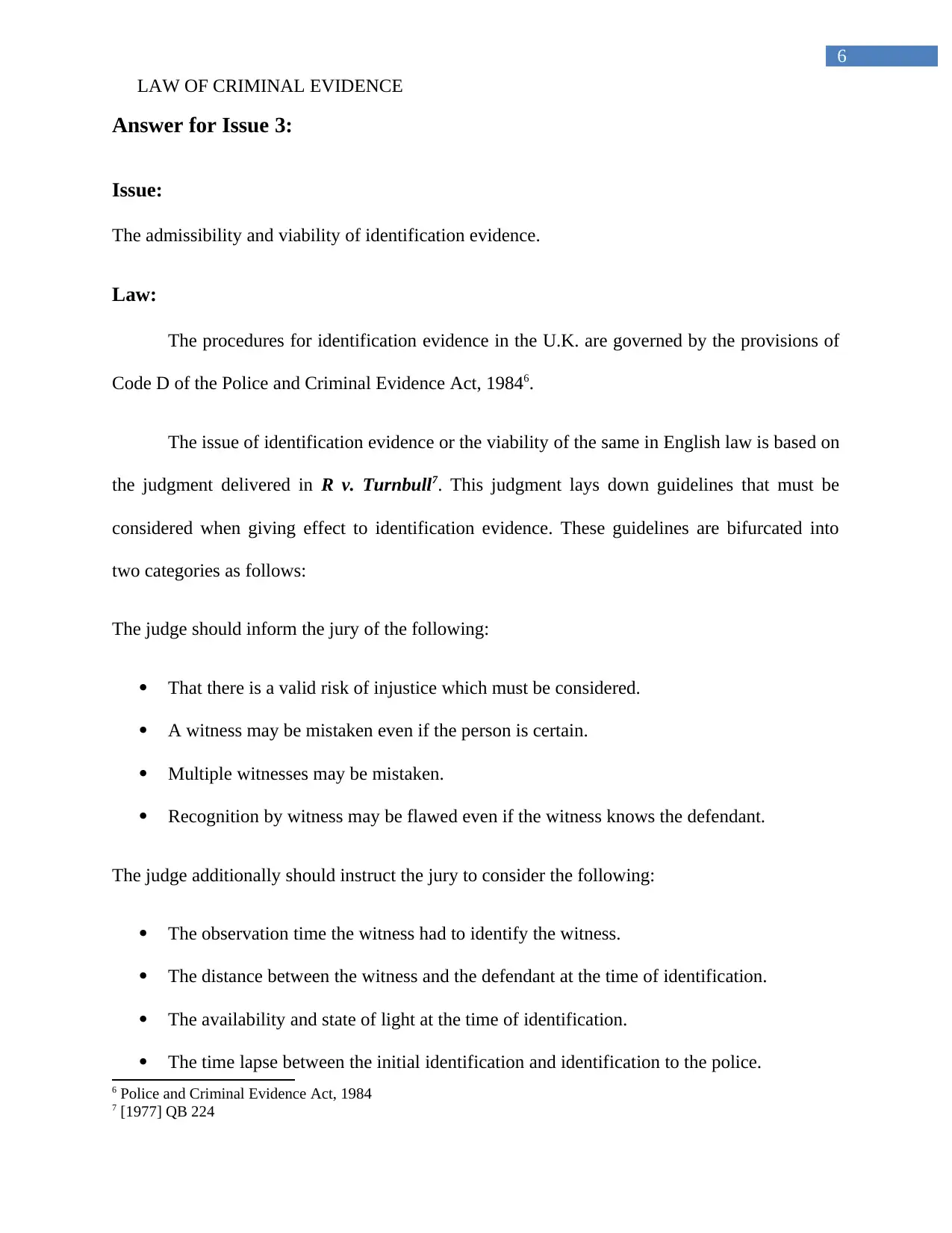
6
LAW OF CRIMINAL EVIDENCE
Answer for Issue 3:
Issue:
The admissibility and viability of identification evidence.
Law:
The procedures for identification evidence in the U.K. are governed by the provisions of
Code D of the Police and Criminal Evidence Act, 19846.
The issue of identification evidence or the viability of the same in English law is based on
the judgment delivered in R v. Turnbull7. This judgment lays down guidelines that must be
considered when giving effect to identification evidence. These guidelines are bifurcated into
two categories as follows:
The judge should inform the jury of the following:
That there is a valid risk of injustice which must be considered.
A witness may be mistaken even if the person is certain.
Multiple witnesses may be mistaken.
Recognition by witness may be flawed even if the witness knows the defendant.
The judge additionally should instruct the jury to consider the following:
The observation time the witness had to identify the witness.
The distance between the witness and the defendant at the time of identification.
The availability and state of light at the time of identification.
The time lapse between the initial identification and identification to the police.
6 Police and Criminal Evidence Act, 1984
7 [1977] QB 224
LAW OF CRIMINAL EVIDENCE
Answer for Issue 3:
Issue:
The admissibility and viability of identification evidence.
Law:
The procedures for identification evidence in the U.K. are governed by the provisions of
Code D of the Police and Criminal Evidence Act, 19846.
The issue of identification evidence or the viability of the same in English law is based on
the judgment delivered in R v. Turnbull7. This judgment lays down guidelines that must be
considered when giving effect to identification evidence. These guidelines are bifurcated into
two categories as follows:
The judge should inform the jury of the following:
That there is a valid risk of injustice which must be considered.
A witness may be mistaken even if the person is certain.
Multiple witnesses may be mistaken.
Recognition by witness may be flawed even if the witness knows the defendant.
The judge additionally should instruct the jury to consider the following:
The observation time the witness had to identify the witness.
The distance between the witness and the defendant at the time of identification.
The availability and state of light at the time of identification.
The time lapse between the initial identification and identification to the police.
6 Police and Criminal Evidence Act, 1984
7 [1977] QB 224
Paraphrase This Document
Need a fresh take? Get an instant paraphrase of this document with our AI Paraphraser
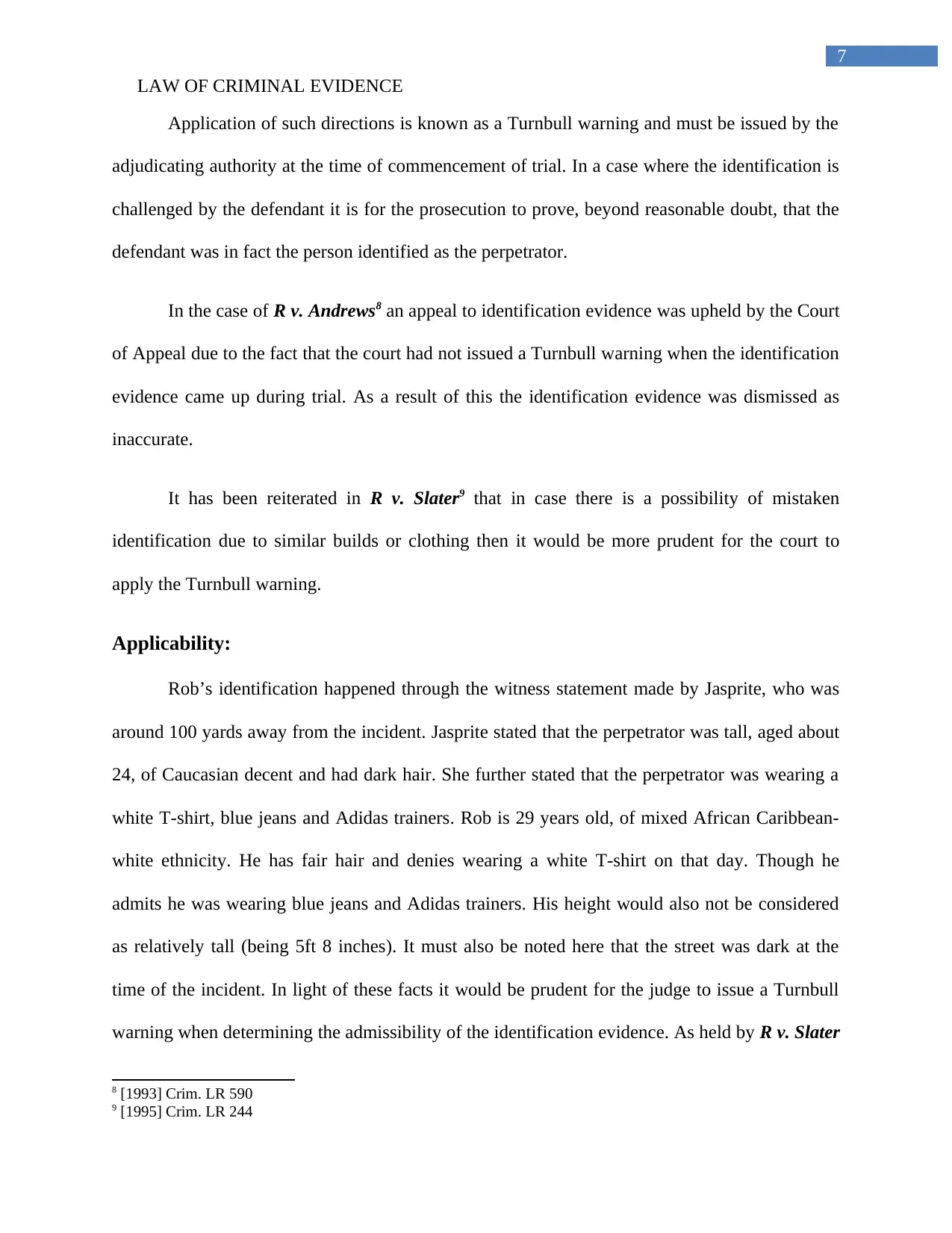
7
LAW OF CRIMINAL EVIDENCE
Application of such directions is known as a Turnbull warning and must be issued by the
adjudicating authority at the time of commencement of trial. In a case where the identification is
challenged by the defendant it is for the prosecution to prove, beyond reasonable doubt, that the
defendant was in fact the person identified as the perpetrator.
In the case of R v. Andrews8 an appeal to identification evidence was upheld by the Court
of Appeal due to the fact that the court had not issued a Turnbull warning when the identification
evidence came up during trial. As a result of this the identification evidence was dismissed as
inaccurate.
It has been reiterated in R v. Slater9 that in case there is a possibility of mistaken
identification due to similar builds or clothing then it would be more prudent for the court to
apply the Turnbull warning.
Applicability:
Rob’s identification happened through the witness statement made by Jasprite, who was
around 100 yards away from the incident. Jasprite stated that the perpetrator was tall, aged about
24, of Caucasian decent and had dark hair. She further stated that the perpetrator was wearing a
white T-shirt, blue jeans and Adidas trainers. Rob is 29 years old, of mixed African Caribbean-
white ethnicity. He has fair hair and denies wearing a white T-shirt on that day. Though he
admits he was wearing blue jeans and Adidas trainers. His height would also not be considered
as relatively tall (being 5ft 8 inches). It must also be noted here that the street was dark at the
time of the incident. In light of these facts it would be prudent for the judge to issue a Turnbull
warning when determining the admissibility of the identification evidence. As held by R v. Slater
8 [1993] Crim. LR 590
9 [1995] Crim. LR 244
LAW OF CRIMINAL EVIDENCE
Application of such directions is known as a Turnbull warning and must be issued by the
adjudicating authority at the time of commencement of trial. In a case where the identification is
challenged by the defendant it is for the prosecution to prove, beyond reasonable doubt, that the
defendant was in fact the person identified as the perpetrator.
In the case of R v. Andrews8 an appeal to identification evidence was upheld by the Court
of Appeal due to the fact that the court had not issued a Turnbull warning when the identification
evidence came up during trial. As a result of this the identification evidence was dismissed as
inaccurate.
It has been reiterated in R v. Slater9 that in case there is a possibility of mistaken
identification due to similar builds or clothing then it would be more prudent for the court to
apply the Turnbull warning.
Applicability:
Rob’s identification happened through the witness statement made by Jasprite, who was
around 100 yards away from the incident. Jasprite stated that the perpetrator was tall, aged about
24, of Caucasian decent and had dark hair. She further stated that the perpetrator was wearing a
white T-shirt, blue jeans and Adidas trainers. Rob is 29 years old, of mixed African Caribbean-
white ethnicity. He has fair hair and denies wearing a white T-shirt on that day. Though he
admits he was wearing blue jeans and Adidas trainers. His height would also not be considered
as relatively tall (being 5ft 8 inches). It must also be noted here that the street was dark at the
time of the incident. In light of these facts it would be prudent for the judge to issue a Turnbull
warning when determining the admissibility of the identification evidence. As held by R v. Slater
8 [1993] Crim. LR 590
9 [1995] Crim. LR 244
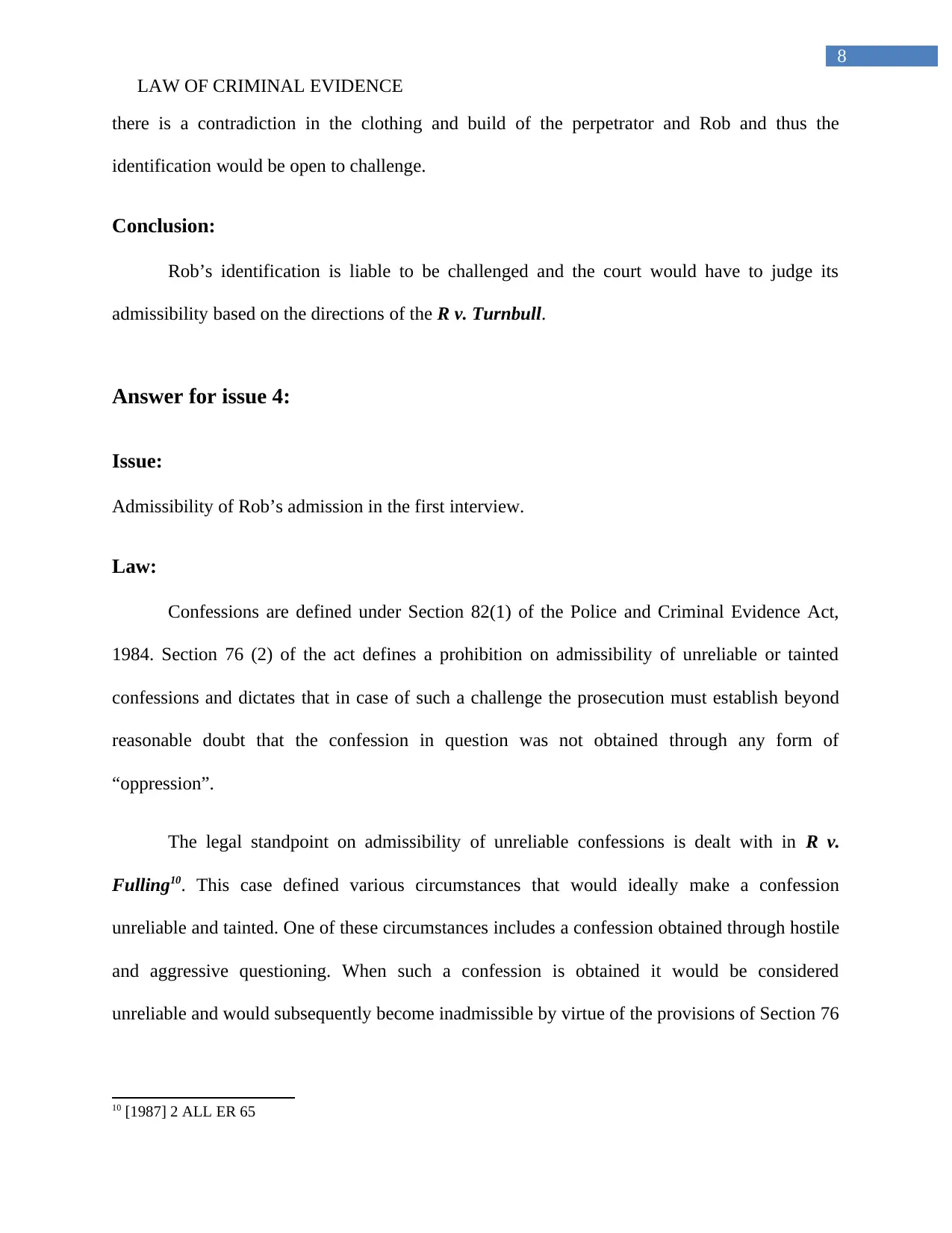
8
LAW OF CRIMINAL EVIDENCE
there is a contradiction in the clothing and build of the perpetrator and Rob and thus the
identification would be open to challenge.
Conclusion:
Rob’s identification is liable to be challenged and the court would have to judge its
admissibility based on the directions of the R v. Turnbull.
Answer for issue 4:
Issue:
Admissibility of Rob’s admission in the first interview.
Law:
Confessions are defined under Section 82(1) of the Police and Criminal Evidence Act,
1984. Section 76 (2) of the act defines a prohibition on admissibility of unreliable or tainted
confessions and dictates that in case of such a challenge the prosecution must establish beyond
reasonable doubt that the confession in question was not obtained through any form of
“oppression”.
The legal standpoint on admissibility of unreliable confessions is dealt with in R v.
Fulling10. This case defined various circumstances that would ideally make a confession
unreliable and tainted. One of these circumstances includes a confession obtained through hostile
and aggressive questioning. When such a confession is obtained it would be considered
unreliable and would subsequently become inadmissible by virtue of the provisions of Section 76
10 [1987] 2 ALL ER 65
LAW OF CRIMINAL EVIDENCE
there is a contradiction in the clothing and build of the perpetrator and Rob and thus the
identification would be open to challenge.
Conclusion:
Rob’s identification is liable to be challenged and the court would have to judge its
admissibility based on the directions of the R v. Turnbull.
Answer for issue 4:
Issue:
Admissibility of Rob’s admission in the first interview.
Law:
Confessions are defined under Section 82(1) of the Police and Criminal Evidence Act,
1984. Section 76 (2) of the act defines a prohibition on admissibility of unreliable or tainted
confessions and dictates that in case of such a challenge the prosecution must establish beyond
reasonable doubt that the confession in question was not obtained through any form of
“oppression”.
The legal standpoint on admissibility of unreliable confessions is dealt with in R v.
Fulling10. This case defined various circumstances that would ideally make a confession
unreliable and tainted. One of these circumstances includes a confession obtained through hostile
and aggressive questioning. When such a confession is obtained it would be considered
unreliable and would subsequently become inadmissible by virtue of the provisions of Section 76
10 [1987] 2 ALL ER 65
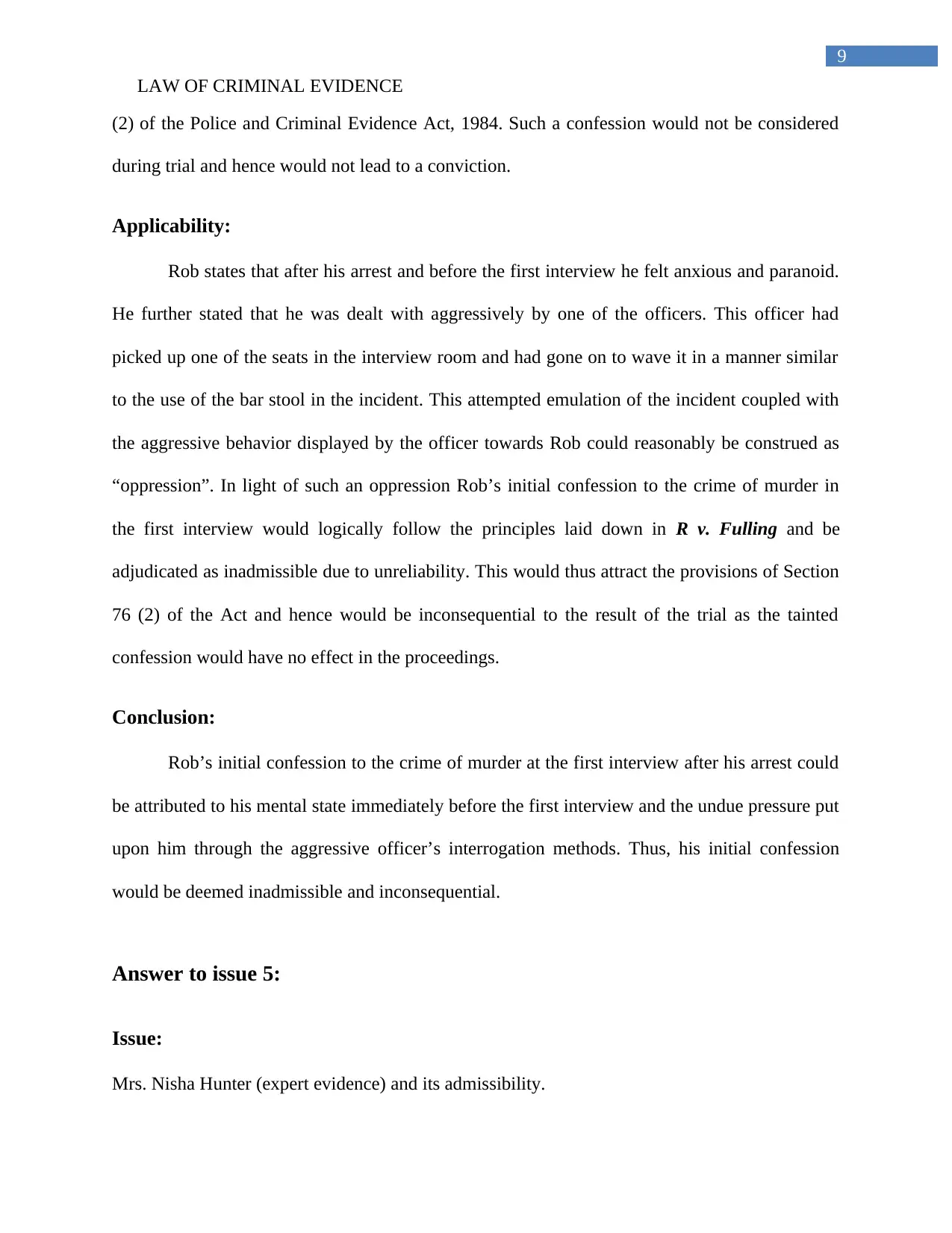
9
LAW OF CRIMINAL EVIDENCE
(2) of the Police and Criminal Evidence Act, 1984. Such a confession would not be considered
during trial and hence would not lead to a conviction.
Applicability:
Rob states that after his arrest and before the first interview he felt anxious and paranoid.
He further stated that he was dealt with aggressively by one of the officers. This officer had
picked up one of the seats in the interview room and had gone on to wave it in a manner similar
to the use of the bar stool in the incident. This attempted emulation of the incident coupled with
the aggressive behavior displayed by the officer towards Rob could reasonably be construed as
“oppression”. In light of such an oppression Rob’s initial confession to the crime of murder in
the first interview would logically follow the principles laid down in R v. Fulling and be
adjudicated as inadmissible due to unreliability. This would thus attract the provisions of Section
76 (2) of the Act and hence would be inconsequential to the result of the trial as the tainted
confession would have no effect in the proceedings.
Conclusion:
Rob’s initial confession to the crime of murder at the first interview after his arrest could
be attributed to his mental state immediately before the first interview and the undue pressure put
upon him through the aggressive officer’s interrogation methods. Thus, his initial confession
would be deemed inadmissible and inconsequential.
Answer to issue 5:
Issue:
Mrs. Nisha Hunter (expert evidence) and its admissibility.
LAW OF CRIMINAL EVIDENCE
(2) of the Police and Criminal Evidence Act, 1984. Such a confession would not be considered
during trial and hence would not lead to a conviction.
Applicability:
Rob states that after his arrest and before the first interview he felt anxious and paranoid.
He further stated that he was dealt with aggressively by one of the officers. This officer had
picked up one of the seats in the interview room and had gone on to wave it in a manner similar
to the use of the bar stool in the incident. This attempted emulation of the incident coupled with
the aggressive behavior displayed by the officer towards Rob could reasonably be construed as
“oppression”. In light of such an oppression Rob’s initial confession to the crime of murder in
the first interview would logically follow the principles laid down in R v. Fulling and be
adjudicated as inadmissible due to unreliability. This would thus attract the provisions of Section
76 (2) of the Act and hence would be inconsequential to the result of the trial as the tainted
confession would have no effect in the proceedings.
Conclusion:
Rob’s initial confession to the crime of murder at the first interview after his arrest could
be attributed to his mental state immediately before the first interview and the undue pressure put
upon him through the aggressive officer’s interrogation methods. Thus, his initial confession
would be deemed inadmissible and inconsequential.
Answer to issue 5:
Issue:
Mrs. Nisha Hunter (expert evidence) and its admissibility.
Secure Best Marks with AI Grader
Need help grading? Try our AI Grader for instant feedback on your assignments.
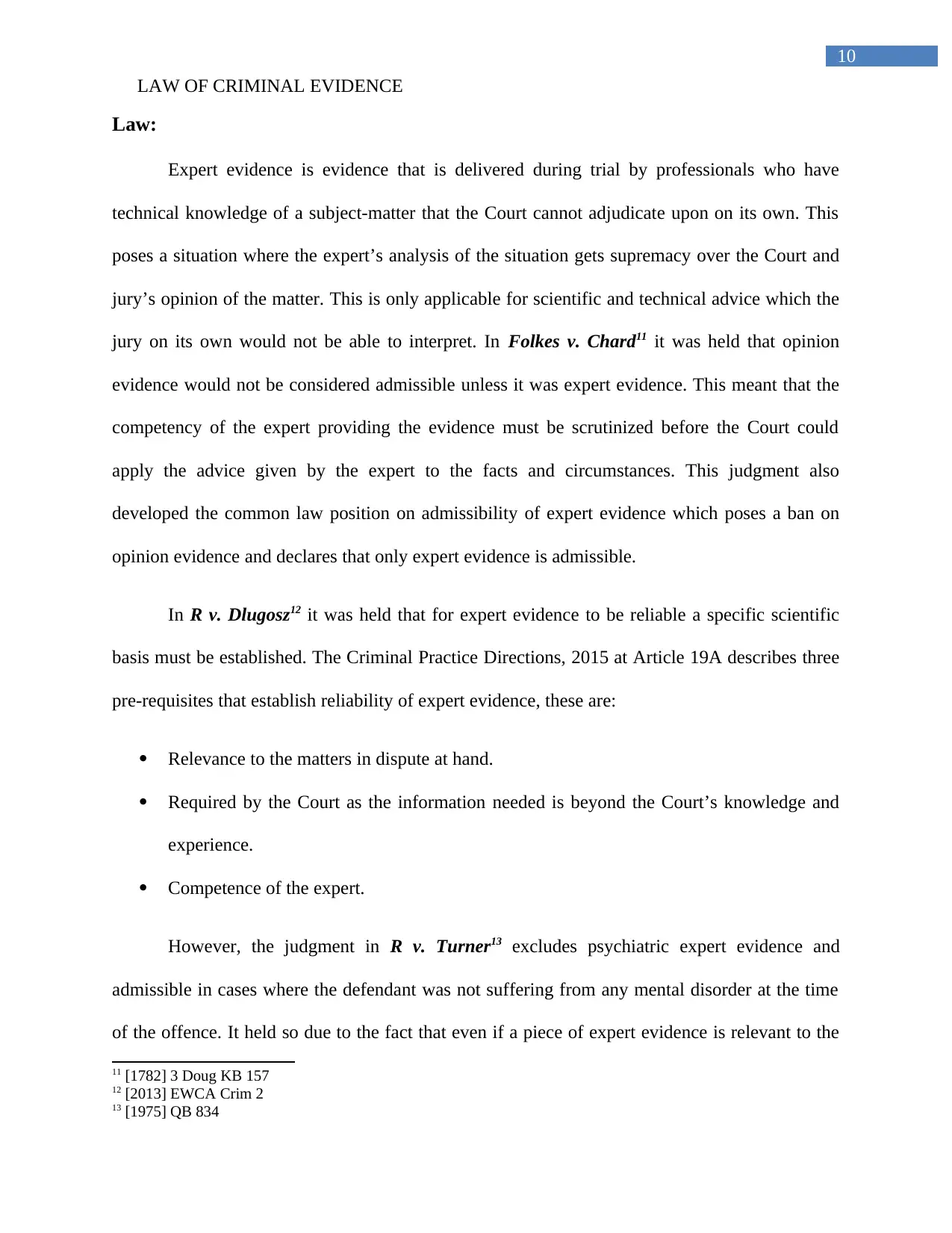
10
LAW OF CRIMINAL EVIDENCE
Law:
Expert evidence is evidence that is delivered during trial by professionals who have
technical knowledge of a subject-matter that the Court cannot adjudicate upon on its own. This
poses a situation where the expert’s analysis of the situation gets supremacy over the Court and
jury’s opinion of the matter. This is only applicable for scientific and technical advice which the
jury on its own would not be able to interpret. In Folkes v. Chard11 it was held that opinion
evidence would not be considered admissible unless it was expert evidence. This meant that the
competency of the expert providing the evidence must be scrutinized before the Court could
apply the advice given by the expert to the facts and circumstances. This judgment also
developed the common law position on admissibility of expert evidence which poses a ban on
opinion evidence and declares that only expert evidence is admissible.
In R v. Dlugosz12 it was held that for expert evidence to be reliable a specific scientific
basis must be established. The Criminal Practice Directions, 2015 at Article 19A describes three
pre-requisites that establish reliability of expert evidence, these are:
Relevance to the matters in dispute at hand.
Required by the Court as the information needed is beyond the Court’s knowledge and
experience.
Competence of the expert.
However, the judgment in R v. Turner13 excludes psychiatric expert evidence and
admissible in cases where the defendant was not suffering from any mental disorder at the time
of the offence. It held so due to the fact that even if a piece of expert evidence is relevant to the
11 [1782] 3 Doug KB 157
12 [2013] EWCA Crim 2
13 [1975] QB 834
LAW OF CRIMINAL EVIDENCE
Law:
Expert evidence is evidence that is delivered during trial by professionals who have
technical knowledge of a subject-matter that the Court cannot adjudicate upon on its own. This
poses a situation where the expert’s analysis of the situation gets supremacy over the Court and
jury’s opinion of the matter. This is only applicable for scientific and technical advice which the
jury on its own would not be able to interpret. In Folkes v. Chard11 it was held that opinion
evidence would not be considered admissible unless it was expert evidence. This meant that the
competency of the expert providing the evidence must be scrutinized before the Court could
apply the advice given by the expert to the facts and circumstances. This judgment also
developed the common law position on admissibility of expert evidence which poses a ban on
opinion evidence and declares that only expert evidence is admissible.
In R v. Dlugosz12 it was held that for expert evidence to be reliable a specific scientific
basis must be established. The Criminal Practice Directions, 2015 at Article 19A describes three
pre-requisites that establish reliability of expert evidence, these are:
Relevance to the matters in dispute at hand.
Required by the Court as the information needed is beyond the Court’s knowledge and
experience.
Competence of the expert.
However, the judgment in R v. Turner13 excludes psychiatric expert evidence and
admissible in cases where the defendant was not suffering from any mental disorder at the time
of the offence. It held so due to the fact that even if a piece of expert evidence is relevant to the
11 [1782] 3 Doug KB 157
12 [2013] EWCA Crim 2
13 [1975] QB 834
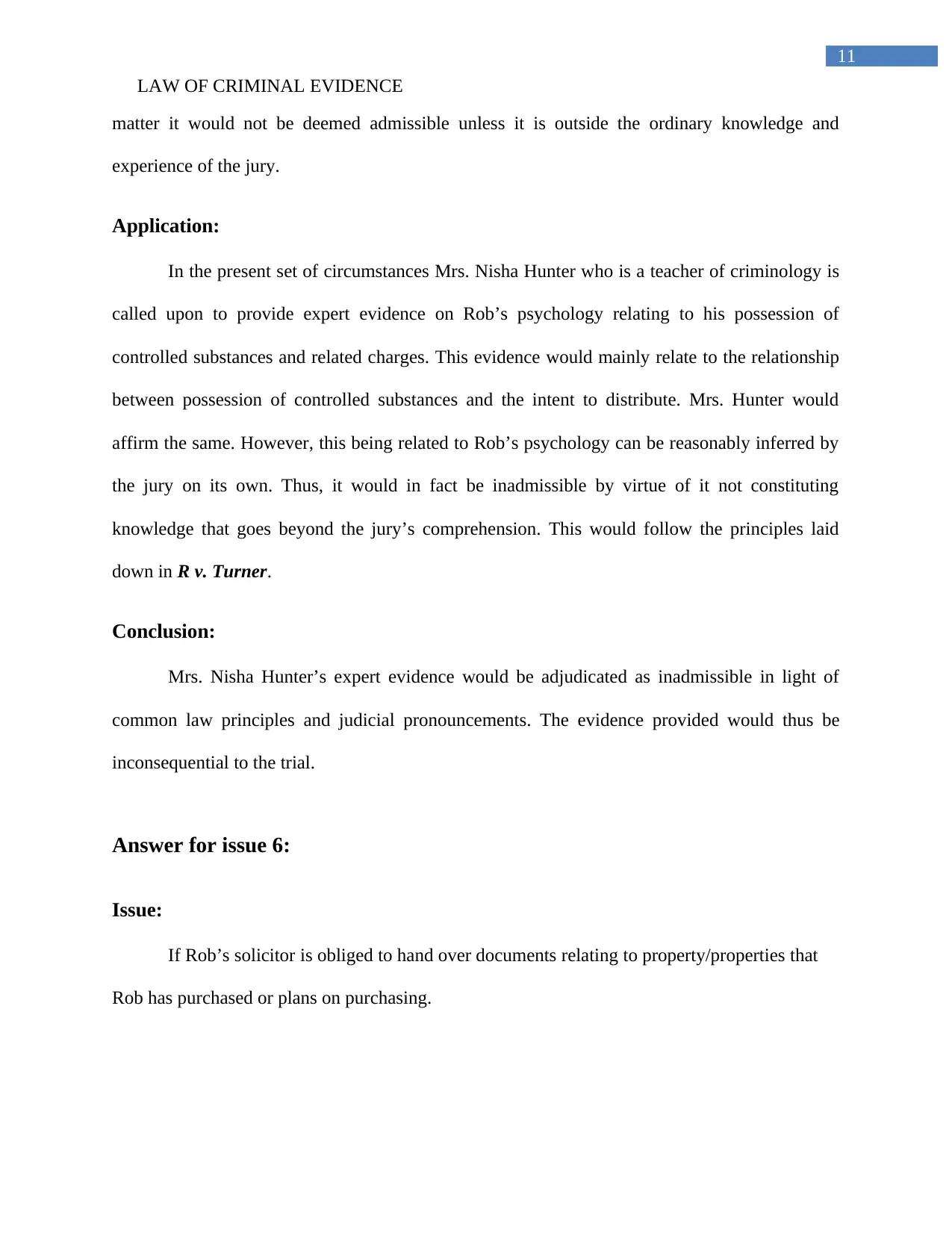
11
LAW OF CRIMINAL EVIDENCE
matter it would not be deemed admissible unless it is outside the ordinary knowledge and
experience of the jury.
Application:
In the present set of circumstances Mrs. Nisha Hunter who is a teacher of criminology is
called upon to provide expert evidence on Rob’s psychology relating to his possession of
controlled substances and related charges. This evidence would mainly relate to the relationship
between possession of controlled substances and the intent to distribute. Mrs. Hunter would
affirm the same. However, this being related to Rob’s psychology can be reasonably inferred by
the jury on its own. Thus, it would in fact be inadmissible by virtue of it not constituting
knowledge that goes beyond the jury’s comprehension. This would follow the principles laid
down in R v. Turner.
Conclusion:
Mrs. Nisha Hunter’s expert evidence would be adjudicated as inadmissible in light of
common law principles and judicial pronouncements. The evidence provided would thus be
inconsequential to the trial.
Answer for issue 6:
Issue:
If Rob’s solicitor is obliged to hand over documents relating to property/properties that
Rob has purchased or plans on purchasing.
LAW OF CRIMINAL EVIDENCE
matter it would not be deemed admissible unless it is outside the ordinary knowledge and
experience of the jury.
Application:
In the present set of circumstances Mrs. Nisha Hunter who is a teacher of criminology is
called upon to provide expert evidence on Rob’s psychology relating to his possession of
controlled substances and related charges. This evidence would mainly relate to the relationship
between possession of controlled substances and the intent to distribute. Mrs. Hunter would
affirm the same. However, this being related to Rob’s psychology can be reasonably inferred by
the jury on its own. Thus, it would in fact be inadmissible by virtue of it not constituting
knowledge that goes beyond the jury’s comprehension. This would follow the principles laid
down in R v. Turner.
Conclusion:
Mrs. Nisha Hunter’s expert evidence would be adjudicated as inadmissible in light of
common law principles and judicial pronouncements. The evidence provided would thus be
inconsequential to the trial.
Answer for issue 6:
Issue:
If Rob’s solicitor is obliged to hand over documents relating to property/properties that
Rob has purchased or plans on purchasing.
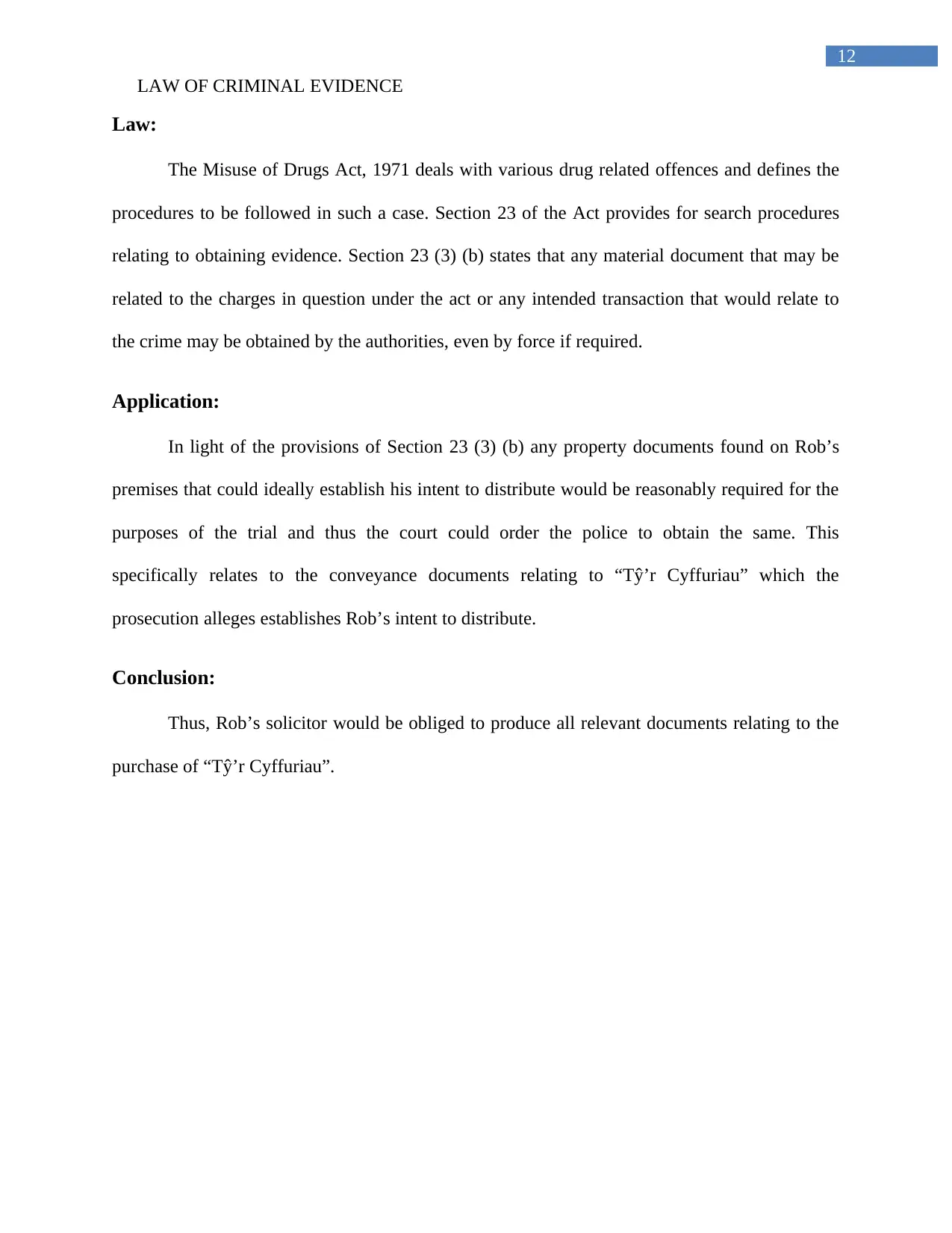
12
LAW OF CRIMINAL EVIDENCE
Law:
The Misuse of Drugs Act, 1971 deals with various drug related offences and defines the
procedures to be followed in such a case. Section 23 of the Act provides for search procedures
relating to obtaining evidence. Section 23 (3) (b) states that any material document that may be
related to the charges in question under the act or any intended transaction that would relate to
the crime may be obtained by the authorities, even by force if required.
Application:
In light of the provisions of Section 23 (3) (b) any property documents found on Rob’s
premises that could ideally establish his intent to distribute would be reasonably required for the
purposes of the trial and thus the court could order the police to obtain the same. This
specifically relates to the conveyance documents relating to “Tŷ’r Cyffuriau” which the
prosecution alleges establishes Rob’s intent to distribute.
Conclusion:
Thus, Rob’s solicitor would be obliged to produce all relevant documents relating to the
purchase of “Tŷ’r Cyffuriau”.
LAW OF CRIMINAL EVIDENCE
Law:
The Misuse of Drugs Act, 1971 deals with various drug related offences and defines the
procedures to be followed in such a case. Section 23 of the Act provides for search procedures
relating to obtaining evidence. Section 23 (3) (b) states that any material document that may be
related to the charges in question under the act or any intended transaction that would relate to
the crime may be obtained by the authorities, even by force if required.
Application:
In light of the provisions of Section 23 (3) (b) any property documents found on Rob’s
premises that could ideally establish his intent to distribute would be reasonably required for the
purposes of the trial and thus the court could order the police to obtain the same. This
specifically relates to the conveyance documents relating to “Tŷ’r Cyffuriau” which the
prosecution alleges establishes Rob’s intent to distribute.
Conclusion:
Thus, Rob’s solicitor would be obliged to produce all relevant documents relating to the
purchase of “Tŷ’r Cyffuriau”.
Paraphrase This Document
Need a fresh take? Get an instant paraphrase of this document with our AI Paraphraser
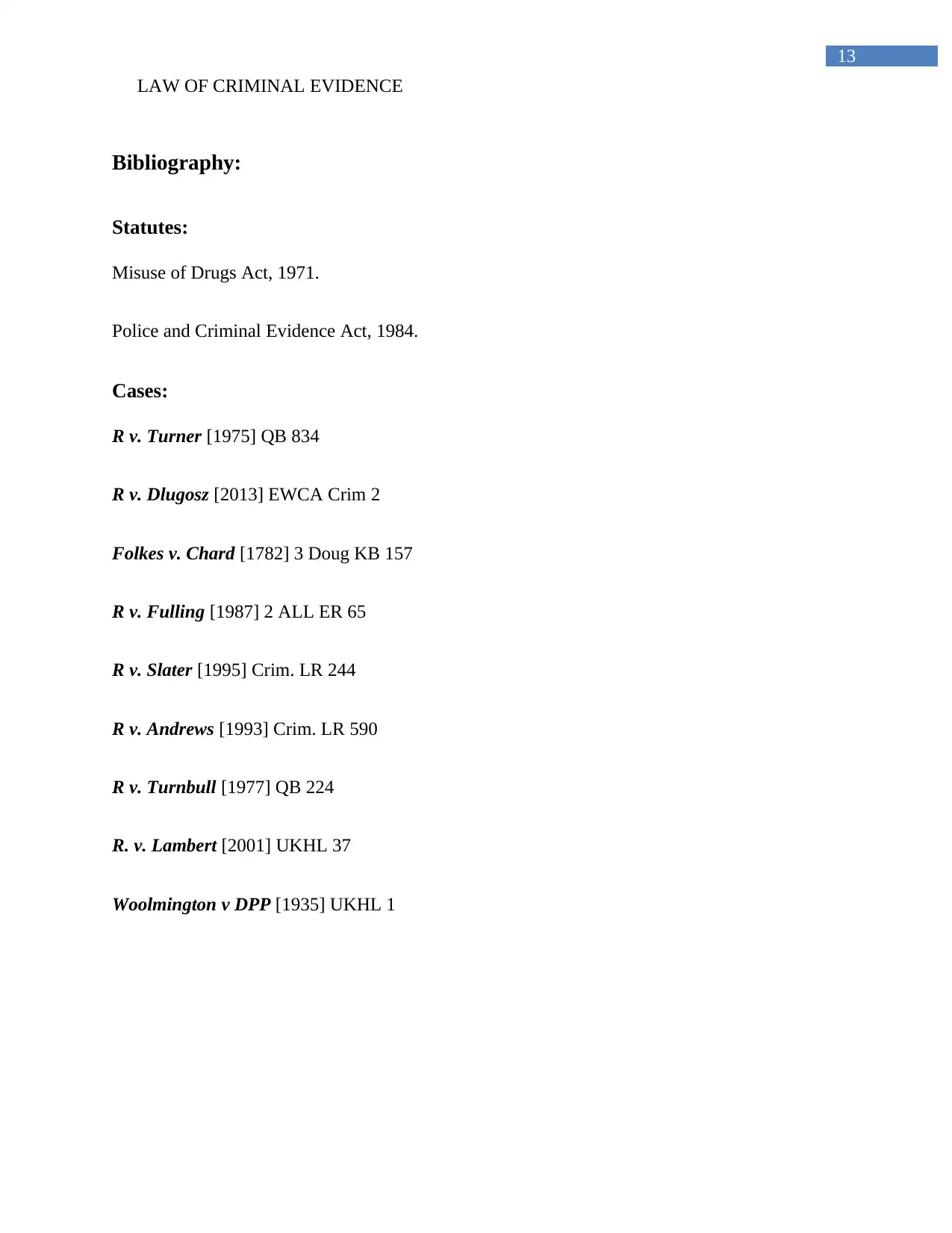
13
LAW OF CRIMINAL EVIDENCE
Bibliography:
Statutes:
Misuse of Drugs Act, 1971.
Police and Criminal Evidence Act, 1984.
Cases:
R v. Turner [1975] QB 834
R v. Dlugosz [2013] EWCA Crim 2
Folkes v. Chard [1782] 3 Doug KB 157
R v. Fulling [1987] 2 ALL ER 65
R v. Slater [1995] Crim. LR 244
R v. Andrews [1993] Crim. LR 590
R v. Turnbull [1977] QB 224
R. v. Lambert [2001] UKHL 37
Woolmington v DPP [1935] UKHL 1
LAW OF CRIMINAL EVIDENCE
Bibliography:
Statutes:
Misuse of Drugs Act, 1971.
Police and Criminal Evidence Act, 1984.
Cases:
R v. Turner [1975] QB 834
R v. Dlugosz [2013] EWCA Crim 2
Folkes v. Chard [1782] 3 Doug KB 157
R v. Fulling [1987] 2 ALL ER 65
R v. Slater [1995] Crim. LR 244
R v. Andrews [1993] Crim. LR 590
R v. Turnbull [1977] QB 224
R. v. Lambert [2001] UKHL 37
Woolmington v DPP [1935] UKHL 1
1 out of 14
Related Documents
Your All-in-One AI-Powered Toolkit for Academic Success.
+13062052269
info@desklib.com
Available 24*7 on WhatsApp / Email
![[object Object]](/_next/static/media/star-bottom.7253800d.svg)
Unlock your academic potential
© 2024 | Zucol Services PVT LTD | All rights reserved.





